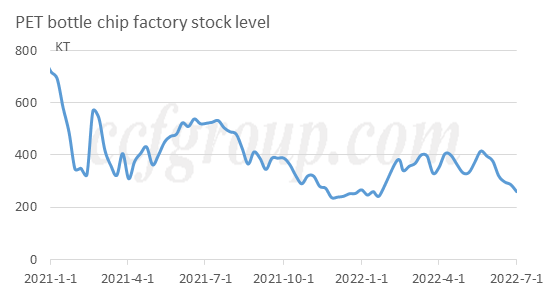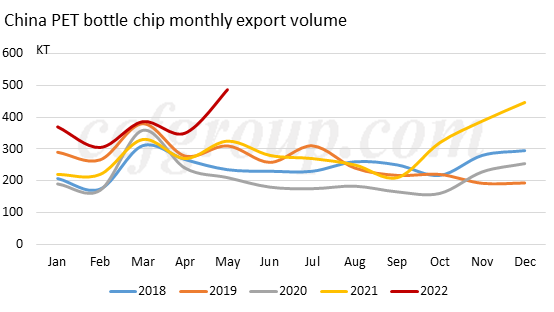PET bottle chip market faces delivery dilemma
Since the Spring Festival in 2022, PET bottle chip performance is among the best among many polyester products. The processing spread of PET bottle chip factory has been more than 1300yuan/ton for a long time, and breaks through 1500-1600yuan/ton in some periods. Recently, with the gradual relaxation of domestic epidemic control measures and the expectation of summer demand growth, many end user customers and traders in the PET bottle chip industry reported that it was difficult to pick up goods from bottle chip factories. The highest price spread between spot and forward goods once reached 500yuan/ton. It’s particularly obvious that spot goods performed stronger than forward goods.
So how long can this trend last?
First, in terms of the market inventory structure, there are not many traders who actually have excess spot inventory on hand, and most of them hold only enough to issue early contracts. At the same time, the inventory of bottle chip factories is gradually declining. As of last Friday, factory inventory averaged around 7 days, higher at 10 days or plus while lower at 4-5 days.

Therefore, although some traders are verbally short, they have actually been forced into long position by the market, and they dare not quote much lower than factory level on spot and near-term goods, in case facing problems in picking up goods from the factory. Forward negotiation range is also basically on a par with factory level. From this point of view, traders’ initiative is restrained in most of the time in H1 2022, they are more of passively following the market fluctuations. In addition, Yisheng has locked most of the sales via contract in advance, so Yisheng goods may gather intensively within the hands of a few contract traders in the future. As these traders lock up the quantity and price, their willingness to short the market reduces, and price fluctuating range is also restricted to a certain extent. In the first half of this year, some traders were unable to carry out the contract when it expires.
Secondly, PET demand in China market was once suppressed to a state of shock in Q2 due to the epidemic control. Domestic demand reduced by 9% year on year during the peak purchasing season from March to May, with a decline of more than 15% in April alone, which has a great impact on the sustainability of demand in the later period. However, it is worth noting that export orders reached 1.19 million tons in the first quarter of this year, while actual delivery was far less than this figure, and there was port congestion in April, hence many orders had to be postponed by about 1-2 months. Taking into account factors such as shipping delays, according to CCFGroup statistics, the total amount of order intake from October last year to June this year was about 3.2 million tons, while domestic export shipments from December last year to May this year were only 2.34 million tons (combine two HS code 110 and 910), which means that nearly 1 million tons goods are to be sent gradually over the next period of time. As a result, shipments from June to August are bound to be not too small.
![UHVG1UFX]~@X~G6H4`(TSMR.png UHVG1UFX]~@X~G6H4`(TSMR.png](https://pic.ccf.com.cn/2022/07/20220705031808115.png)

In Jul-Aug, 4 large PET producers with capacity above 1 million tons are to intensively deliver orders that were delayed by the epidemic control, and the volume may reach 750-800kt in two months. Jul figure is expected to approach 450kt. Normally, the 4 plants take up about 80% of China total PET exports. Hence, if shipping schedule doesn't face serious delay, Jul-Aug export delivery may reach 1 million tons, with Jul alone at more than 500kt. Meanwhile, some large producer has 8-9 ships of bulk goods are to deliver in Jul-Aug, involving 200-300kt goods. Thus, pickup in Jul-Aug may become tighter.
After the fourth quarter, with the intensive delivery coming to an end and new capacity put up online, market supply will gradually resume. Domestic demand will gradually enter off-season, at that time, it is expected that market prices may face some downward pressure, and the processing spread may also be gradually shrink. Of course, if we take into account external factors, such as international crude oil, whether Russia will introduce new countermeasures in the fourth quarter is also worthy of attention.
- Top keywords
- Cotton Price
- Cotton Futures Price
- Cotton Futures
- CZCE
- PTA Futures Price
- Chemical Fiber
- Polyester Prices
- Wool price
- PTA Futures
- Shengze Silk
- China
- Yarn Price
- price
- China Textile City
- Fibre Price
- Benzene Price
- Cotton
- Index
- Cotton Index
- PTA
- fabric price
- NYMEX
- Top 10
- textile industry
- Spot Cotton
- Cotton Yarn
- Polyester Price
- Futures
- PTA Price
- cotton yarn price

